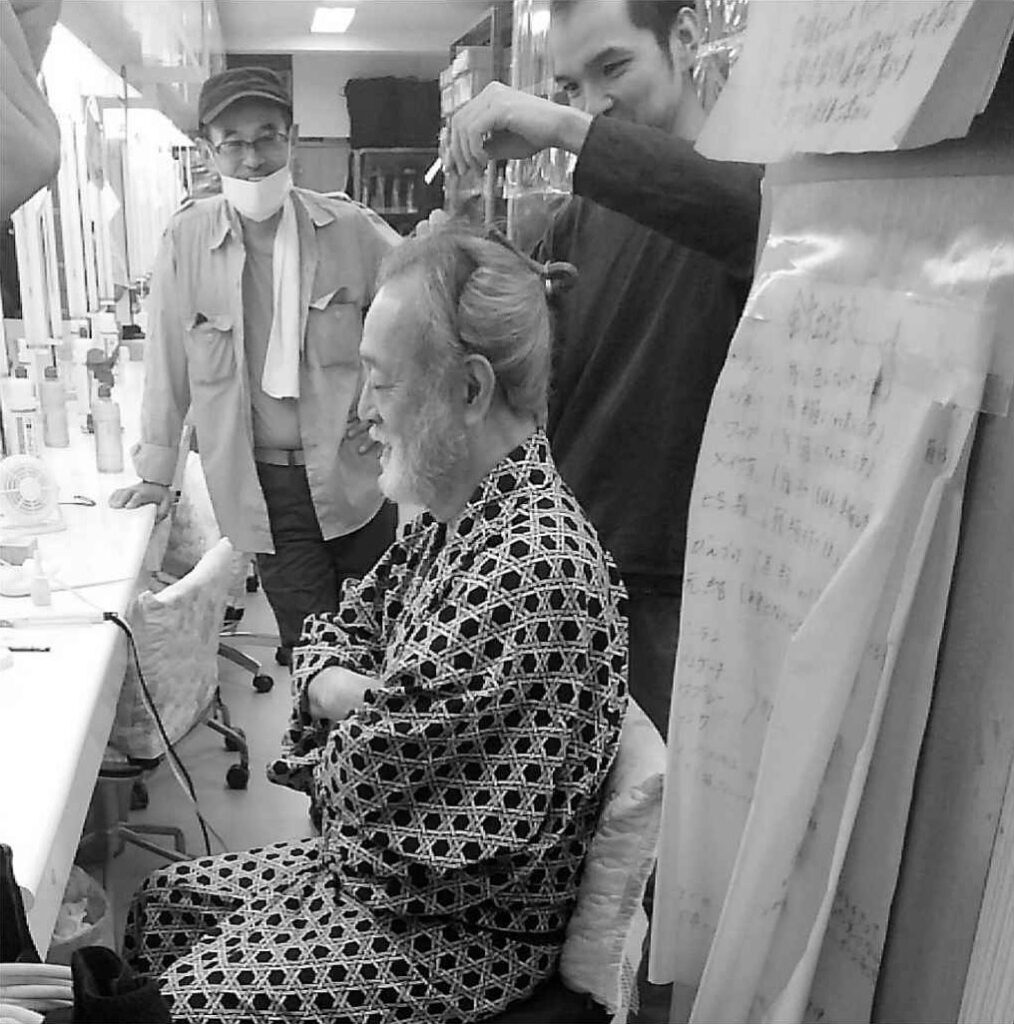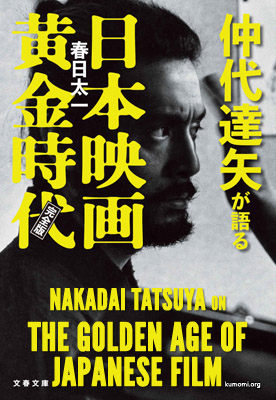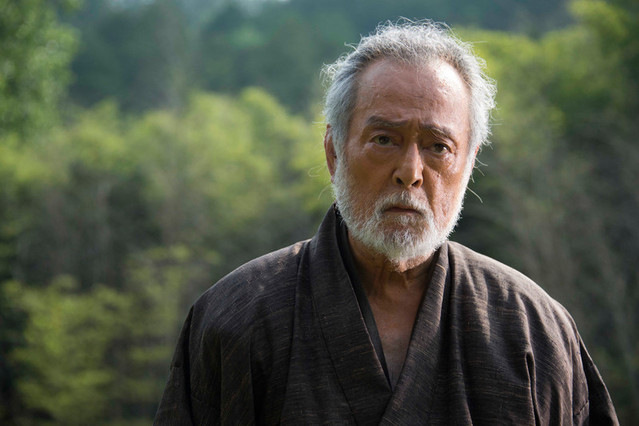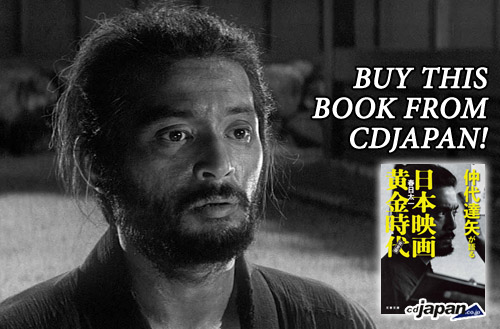On the Set of “A Duel Tale”
Text: Kasuga Taichi
“I previously did an NHK period drama called Seizaemon Zanji Tsuroku, based on a Fujisawa Shuhei novel. I played a rather indifferent, retired samurai, and people seemed to like it very much. I feel like A Duel Tale is kind of a continuation on that theme, and reading the original work, it’s quite interesting indeed. It again depicts a rather negative set of circumstances.
There are disparities among samurai, and the rank of the samurai I’m playing is that of “heyazumi,” meaning that he’s now retired and living a quiet life at home where his family consider him a nuisance. It’s a very sad story, different from the typical kind of sword fighting period drama I’ve done in the past. I feel like it was a project fitting for my age.” —Nakadai
Nakadai Tatsuya recently appeared in his first period drama in a long while. Its title: A Duel Tale. Premiering on October 31, 2015 on the CS channel BS SKY PerfecTV!, it is an original production between SPTV and Jidaigeki Senmon Channel.
From Nakadai’s arrival in Kyoto on June 3, 2015, to when shooting wrapped 15 days later, I went to observe Nakadai on the set of the film almost every day. What did I think of 82-year-old Nakadai Tatsuya’s duel in Kyoto? I would like to write about that at the end of this chapter.
Beginning with 1962’s Harakiri, Nakadai has played in many period drama productions in Kyoto. Especially since the 80s, when Nakadai partnered up with members of production company Eizo Kyoto—consisting of former Daiei Studios Kyoto staff—he starred in a number of Fuji TV period dramas. For the past 20 years or so, however, there had been no new period drama productions in Kyoto, and thus it truly was a long-awaited return.
On the first day of filming, Nakadai was to arrive at Shochiku’s Uzumasa studios in the afternoon. I was there standing by since morning. Familiar faces were showing up one after the other. There was producer Nomura Youichi, formerly of Fuji TV where he used to be in charge of all their productions, and director Inoue Akira who directed most of those productions. The Eizo Kyoto staff were there, too. Everyone had this look on their face like they were exhilarated and yet nervous—an expression I’d never seen before. That’s just how special of an event Nakadai’s return was for these people involved in Kyoto’s period drama scene.
Similarly, it must have felt special for Nakadai to reunite with his old “war buddies.” Arriving to the studio by taxi, he initially looked a bit tense. But being greeted by everybody one-by-one and exchanging handshakes, he soon had this gentle smile on his face as if he had come home. Just from his expression alone, I felt like I could see just how fulfilling the days Nakadai had spent with these people had been for his career.
Here is how Nakadai himself remembers this moment.
“Going back to that Kyoto set felt nostalgic. I’m originally a Tokyo actor, but I would be going to Uzumasa every time we were doing a period drama. But in recent years the period drama scene had lost its momentum, so I hadn’t had the opportunity of going back there as of late. I was thinking to myself, “Uzumasa must be getting pretty lonely, too…”
When I actually got back, the same old staff was there to greet me. “Mr. Nakadai!” “You need to come over more often!” In Uzumasa, the staff are always incredibly supportive of us actors. That sort of lively, considerate “movie people” temperament about them is still the same as it ever was.”
However, there was no time to keep feeling nostalgic. Filming was about to begin.
Entering the waiting room, Nakadai had no time to rest before he had to start getting ready. In order to give Nakadai the perfect reception, Shochiku had organized a highly-skilled group of staff for him, including a certain make-up artist who Nakadai affectionately calls “Yama-chan”—a veteran in his field, he has been working with Nakadai for many years.
Despite it having been a long time since they’d last met, the two came across as so friendly that there was no sense of it being a long-awaited reunion. They spoke of the good old days and told jokes back and forth. While there was some extremely challenging filming ahead, it seemed like whenever Nakadai was having his make-up done by “Yama-chan,” that was one of the few times in his day when he could just relax.

In make-up before a morning shoot
“Yama-chan” (L) having a friendly conversation with Nakadai
The director of the film was Sugita Shigemichi, president of Nihon Eiga Broadcasting Corp. who operate Jidaigeki Senmon Channel. Known for his work on productions such as the TV drama Kita no Kuni Kara, Sugita’s style of direction is very steadfast. Usually scenes are shot with several cuts in between, but Sugita does not do this. Instead, he’ll shoot the whole scene from beginning to end, and then they’ll start all over again from a different angle, once again shooting from beginning to end. In the editing stage, he has complete freedom to cut the material to his liking.
Employing this method results in more footage that can be used in editing, giving the editor more options. But it also puts a greater burden on the actors, as they must successfully perform the same, lengthy scenes over and over again. So was the case with this film, too. Regardless of factors like Nakadai being 82 years of age, Sugita showed no compromise. Day after day, filming would go on from the early hours of the morning until late at night.
Even so, Nakadai never complained or showed any weakness hinting that he might be at his limit. Actually, just before shooting commenced for this film, Nakadai had been visiting New York where he had fallen ill. And yet, the more difficult the filming became—such as a night shoot on a set constructed up in the mountains on an exceptionally freezing June night—the sharper his acting seemed to get. Bearing your personal hardships for the sake of bettering the work—this, I realized, was at the core of Nakadai’s philosophy as an actor.
A particular highlight was the 12th day of filming. On this day, Nakadai in his role as “Sanosuke” was doing a scene early in the morning where he was to “swing his sword with his mind and soul to face a tragedy of his past.” Shooting took place on-location in the mountains near the film studio in a particular spot which everyone called “Enzyme.” It was a blazing hot day. Moreover, there was no shade at all in the vicinity. Nakadai was not in good health to begin with, and considering how the filming was now in its end stages, the 82-year-old must surely have felt fatigued by this point. No matter how I looked at it, this felt like it was just too much.
“I’m going to be playing the lead in a period drama in my eighties. There are fight scenes, too. My body still remembers all those fights I’ve done in the past, but the question is: will my body be able to keep up? In any case, I want to avoid using stand-ins as much as possible.”
That is how Nakadai expressed his eagerness before filming began. And just as he’d proclaimed, aside from when they did a test shoot to check camera positioning, they didn’t use stand-ins even once—Nakadai took on the sword fight scenes by himself. No matter what the situation, he never makes excuses to himself nor the staff. Never getting soft, always meeting all demands. That is Nakadai Tatsuya. Once again, I could understand why all the masters have given this man their love and their trust.
And so, amidst all this, filming for the day finally began. First, they went through the sword drawing and stances with the sword fight choreographer. While it had been a long time since Nakadai’s last period drama, the training he had done in his youth was all still there. The choreographer hardly had any guidance to give him.
He handled his sword with ease, and seeing up-close the weight of his stance and the sharpness of his swing, it all had an enchanting intensity.
Once the sun had fully risen, it was time for him to swing the sword in practice. But it wasn’t just swinging—his sword had to actually cut plants and vegetation, and so he used not an imitation sword, but a real one. It was quite heavy, and despite Nakadai continuing to swing it intently under the blazing hot sun, not once did he show signs of fatigue when the cameras were rolling.
But in fact, behind the scenes he was suffering from chronic asthma attacks, and during breaks in filming he would be gasping for air from his oxygen inhaler. And yet, each time he stood up in front of the camera, he immediately had that “look of an actor” on his face again. The more he swung his sword, the more those big eyes of his shone like he was possessed. His whole body exuded an intense feeling of bloodlust. Seeing madness personified like this right in front of me, for an instant I actually thought to myself, “He might cut me down, too.”
But that wasn’t the end of the day’s filming. We got back to the film studio in the evening, and after a few hours of rest it was time for an on-location night shoot. Furthermore, it was the very duel scene that was to be the climax of the film. It was already going to be a very intense action sequence with sword fighting, and furthermore it was going to be shot at nighttime. In his present condition, I wondered if Nakadai’s body could actually take it.
I would soon find out that it wasn’t so much that I was naive, but rather how me worrying about him in that manner was actually incredibly rude towards Nakadai.
Although it looked like Nakadai had expended all his energy in the daytime shoot, it didn’t take him long to recover. Seeing Nakadai happily joking around with “Yama-chan” on the one-hour car ride to the next location, it started to seem like I might’ve imagined it all—Nakadai swinging his sword just moments earlier under the blazing sun in what must’ve been over 30 degrees Celsius weather, looking like he was in pain while walking towards his oxygen inhaler, and then almost collapsing back into the waiting room.
The nighttime shoot began at around 10:00 and ended at around 3:00 in the middle of the night. The important “duel scene” was shot near the end, starting well after 1:00 and taking around two hours to film.
Here, Nakadai was simply sublime. The sense of intimidation in the air when he stood face-to-face with his opponent, the speed with which he drew his sword, the vibrancy at the point of his sword, the beauty of his zanshin posture… Having seen his period drama films like Harakiri and Sanjuro, it felt like those very swordsmen themselves—played by “that Nakadai Tatsuya on the screen”—were actually right there in front of me.
Thinking nothing of his ailing physical condition and the grueling filming schedule, witnessing this 82-year-old actor who had not only been swinging his sword the whole day but who still even in the middle of the night could display his immense, unchanging force of the years gone by, I suddenly noticed that my legs were shaking.
“A professional actor has to be ready to meet any and all demands from the director.”
This is something that Nakadai has said many times throughout our interviews in this book. Rest assured: there is no falsehood in his words. Having seen him working on this movie, I now know it to be true. No matter how difficult the circumstances, the words “I can’t do it” were never in his vocabulary. He met all demands from the production team and the director, silently and flawlessly. Nothing about him has changed from the days when he was constantly overcoming difficult shoots in the Golden Age of Japanese Film.
Here was the very image of a true professional.
“Actors are like athletes.”
This, too, is something that Nakadai will often say. He says so with the nuance that, like athletes, actors too must train physically in order to perform. But there’s more to it than that. Just like how an athlete will work himself to the bone, putting his heart and soul into trying to beat his previous time by even a tenth of a second, the actor too continues to devote himself completely in trying to beat his previous performance. Having seen him on set and on the stage, I can’t help but think that Nakadai is driven by such athlete-like mentality.
But unlike athletes, actors do not have any precise criteria like “time” or “position” with which to measure their personal bests. Like going against an invisible wall that you personally have set up against yourself, it is an absurd struggle. If at any point you feel satisfied that you have done all you can, you stop desiring further improvement. Nakadai has continued to reject that feeling of complacency, instead always striving to outdo himself once more.
Even now, this legendary actor continues to create new legends.



